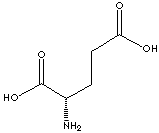| D-GLUTAMIC ACID | ||
|
PRODUCT IDENTIFICATION |
||
| CAS NO. | 6893-26-1 |
|
| EINECS NO. |
230-000-8 |
|
| FORMULA | C5H9NO4 | |
| MOL WT. | 147.13 | |
|
H.S. CODE |
2922.49 | |
| SMILES |
|
|
|
TOXICITY |
|
|
| SYNONYMS | H-DGlu-OH; D-2-Aminoglutaric acid; D-Glutaminic acid; | |
|
CLASSIFICATION |
||
|
PHYSICAL AND CHEMICAL PROPERTIES |
||
| PHYSICAL STATE |
white crystals |
|
| MELTING POINT | 200 C (Decomposes) | |
| BOILING POINT | ||
| SPECIFIC GRAVITY |
|
|
| SOLUBILITY IN WATER | ||
| pH | ||
| VAPOR DENSITY |
|
|
|
AUTOIGNITION |
|
|
|
NFPA RATINGS |
Health: 1; Flammability: 0; Reactivity: 0 | |
|
REFRACTIVE INDEX |
|
|
| FLASH POINT |
|
|
| STABILITY |
Stable under ordinary conditions. Moisture, light sensitive. |
|
|
GENERAL DESCRIPTION |
||
| Amino Acid is any of the organic compounds in which one (or more ) amino group (-NH2) and one (or more ) carboxylic acid group (-COOH) are both present with general formula R-CH(NH2)COOH containing carbon, hydrogen, oxygen, nitrogen, and in certain cases sulfur atoms. Two groups attached to the same carbon (called the alpha-carbon atom at the end of the compound) are polymerized to form peptides and proteins. The amine group is protonated to form -NH3+ at low pH. The carboxylic acid group is deprotonated to form -CO2- at high pH. The carbon atom in the carboxyl group of one amino acid binds covalently to the nitrogen atom in the amino group of another amino acid to form a peptide bond with the release of a water molecule. Proteins are synthesized through the covalent chemical polypeptide bonds. The sequence of these amino acids in the protein polypeptides determines the shape, properties, and hence biological role of the protein that function as chemical messengers and as intermediates in metabolism. Proteins are composed of various proportions of about 20 commonly occurring amino acids. Plants or other biological systems can synthesize amino acids from simple inorganic compounds, but animals rely on adequate supplies in their diet. More than 100 common amino acids occur in plants or in other microorganic systems. The 20 amino acids commonly found in animals are Alanine, Arginine, Asparagine, Aspartic Acid, Cysteine, Glutamic Acid, Glutamine, Glycine, Histidine, Isoleucine, Leucine, Lysine, Methionine, Phenylalanine, Proline, Serine, Threonine, Tryptophan, Tyrosine, and Valine. Many of the amino acids can be synthesized in the human or animal body from other cellular metabolites when needed (called Non-essential Amino Acids). Animals are not able to synthesize some amino acids necessary in metabolism in sufficient quantities. It must therefore be present in the diet (called Essential Amino Acids). In man, these essential amino acids are Arginine, Histidine, Isoleucine, Leucine, Lysine, Methionine, Phenylalanine, Threonine, Tryptophan and Valine. Glutamic acid is a Non-Essential Amino Acid having an acidic carboxyl group on its side chain which can serve as both an acceptor and a donor of ammonia, toxic to the body. Glutamic acid is coupled with ammonia, to transport ammonia saely to the liver, where the ammonia is eventually converted to urea for excretion by the kidneys and to purines (necessary for the synthesis of genetic material). Glutamic acid coupled with ammonia is called glutamine, the monoamide form of glutamic acid. Only the l-stereoisomer occurs in mammalian proteins. It is abundant constituent of proteins. The glutamic acid-glutamine interconversion is of central importance to the regulation of the levels of toxic ammonia in the body. Once glutamine is incorporated into proteins, its relatively unreactive side-chain amide participates in very few reactions. In addition to the fuction of protein synthesis, it participates in important brain function, as an excitatory neurotransmitter. Glutamine is not essential to the human diet, since it can be synthesized in the body from glutamic acid. Free glutamic acid can be converted reversibly to -ketoglutaric acid, an intermediate in the Krebs cycle, and as such can be degraded to carbon dioxide and water, or transformed into sugars. The monosodium salt of l-glutamic acid, is widely used as a condiment. | ||
| SALES SPECIFICATION | ||
|
APPEARANCE |
white crystals |
|
| ASSAY |
98.5 - 101.0% |
|
|
SPECIFIC ROTATION |
-31° ~ -32.5° |
|
|
LOSS ON DRYING |
0.2% max |
|
|
RESIDUE ON IGNITION |
0.1% max |
|
|
CHLORIDE |
0.02% max |
|
|
SULFATE |
0.03% max |
|
|
HEAVY METALS |
10ppm max |
|
|
IRON |
10ppm max |
|
|
ARSENIC |
1ppm max |
|
|
AMMONIUM SALTS |
0.02% max |
|
| TRANSPORTATION | ||
| PACKING |
25kgs
in fiber drum
|
|
| HAZARD CLASS | Not regulated | |
| UN NO. | ||
| OTHER INFORMATION | ||
| Hazard Symbols: n/a, Risk Phrases: n/a, Safety Phrases: 24/25 | ||
